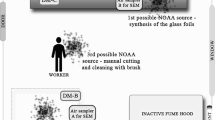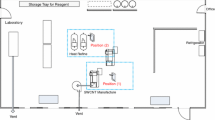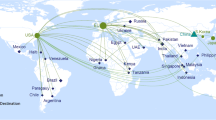Abstract
The use of engineered nanomaterials (ENMs) to improve electronics and computer manufacturing has allowed significant developments in their size and properties. Occupational exposure to ENMs can also occur during the electronic devices recycling (e-cycling) due to the manual and/or destructive disassembly process. This study aimed to characterize the potential exposure of workers to ENMs (10–400 nm) during the demanufacturing process of electronic devices in an e-waste recycling plant. An e-cycling facility with workers performing manual demanufacturing of electronic devices was the focal point of this research. This study used a direct reading instrument (DRI) and traditional air filter samples. Air samples were collected during a work shift using the direct reading TSI NanoScan SMPS and filter-based samples during the normal operation. For the filter-based samples, 16 air samples were collected and analyzed. Real-time NanoScan measurements indicated the plastic shredding activities contributed to the airborne nanoparticles’ generation with a peak of 32,000 particles/cm3. Four heavy metals (Al, Fe, Pb, and Zn) were also detected at low concentrations. Nanoparticle exposures were identified during the operation of a plastic shredder, paper baler and the operation of an electric forklift. Results from the ICPMS analysis, and SEM data from the computer demanufacturing tasks support the hypothesis that the demanufacturing process during e-cycling releases airborne particles at the nanosize.






Similar content being viewed by others
Data availability
The datasets generated and analyzed during the current study are available from the corresponding author on reasonable request.
Code availability
Not applicable.
References
Agency for Toxic Substances and Disease Registry (2020) Toxilogical Profile Lead
Anderlohr C, Schaber K (2015) Direct transfer of gas-borne nanoparticles into liquid suspensions by means of a wet electrostatic precipitator. Aerosol Sci Technol 49(12):1281–90
Bandala ER, Berli M (2019) Engineered nanomaterials (ENMs) and their role at the nexus of Food, Energy, and Water. Materials Sci Energy Technol 2(1):29–40
Barnes Reports (2018) Barnes reports: materials recovery facilities industry (Naics 56292) [Available from: https://www.barnesreports.com/
Beaucham CC, Ceballos D, Mueller C, Page E, La Guardia MJ (2019) Field evaluation of sequential hand wipes for flame retardant exposure in an electronics recycling facility. Chemosphere 219:472–81
Boonruksa P, Bello D, Zhang J, Isaacs JA, Mead JL, Woskie SR (2017) Exposures to nanoparticles and fibers during injection molding and recycling of carbon nanotube reinforced polycarbonate composites. J Exposure Sci Environ Epidemiol 27(4):379–90
Caballero-Guzman A, Sun T, Nowack B (2015) Flows of engineered nanomaterials through the recycling process in Switzerland. Waste management (New York, NY) 36:33–43
Ceballos DM, Dong Z (2016) The formal electronic recycling industry: challenges and opportunities in occupational and environmental health research. Environ Int 95:157–66
Debia M, Bakhiyi B, Ostiguy C, Verbeek JH, Brouwer DH, Murashov V (2016) A systematic review of reported exposure to engineered nanomaterials. Ann Occup Hyg 60(8):916–35
Dutta T, Kim K-H, Deep A, Szulejko JE, Vellingiri K, Kumar S et al (2018) Recovery of nanomaterials from battery and electronic wastes: a new paradigm of environmental waste management. Renew Sustain Energy Rev 82:3694–704
Ellenbecker M, Tsai S (2011) Engineered nanoparticles: safer substitutes for toxic materials, or a new hazard? J Cleaner Prod 19(5):483–7
Ezeah C, Fazakerley JA, Roberts CL (2013) Emerging trends in informal sector recycling in developing and transition countries. Waste management (New York, NY) 33(11):2509–19
Eastlake AC, Beaucham C, Martinez KF, Dahm MM, Sparks C, Hodson LL et al (2016) Refinement of the nanoparticle emission assessment technique into the Nanomaterial Exposure Assessment Technique (NEAT 20). J Occupational Environ Hygiene 13(9):708–17
Garcia A, Eastlake A, Topmiller JL, Sparks C, Martinez K, Geraci CL (2017) Nano-metal oxides: exposure and engineering control assessment. J Occupation Environ Hygiene 14(9):727–37
Goldberg LH, and Middleton W 2000 Green electronics/green bottom line: Environmentally responsible engineering. : Boston: Newnes
Harrison RM, MacKenzie AR, Xu H, Alam MS, Nikolova I, Zhong J et al (2018) Diesel exhaust nanoparticles and their behaviour in the atmosphere. Proceed Royal Soc A: Mathematical, Phys Eng Sci 474(2220):20180492
Hesterberg TW, Long CM, Lapin CA, Hamade AK, Valberg PA (2010) Diesel exhaust particulate (DEP) and nanoparticle exposures: what do DEP human clinical studies tell us about potential human health hazards of nanoparticles? Inhalation Toxicol 22(8):679–94
Jeevanandam J, Barhoum A, Chan YS, Dufresne A, Danquah MK (2018) Review on nanoparticles and nanostructured materials: history, sources, toxicity and regulations. Beilstein J nanotechnol 9:1050–74
Keller AA, McFerran S, Lazareva A, Suh S (2013) Global life cycle releases of engineered nanomaterials. J Nanoparticle Res 15(6):1692
Kim K-H, Kabir E, Kabir S (2015) A review on the human health impact of airborne particulate matter. Environ Int 74:136–43
Liati A, Pandurangi SS, Boulouchos K, Schreiber D, Arroyo Rojas Dasilva Y (2015) Metal nanoparticles in diesel exhaust derived by in-cylinder melting of detached engine fragments. Atmospher Environ 101:34–40
Mattsson M-O, Simkó M (2017) The changing face of nanomaterials: Risk assessment challenges along the value chain. Regulatory Toxicol Pharmacol 84:105–15
Monteiro-Riviere NA, Oldenburg SJ, Inman AO (2010) Interactions of aluminum nanoparticles with human epidermal keratinocytes. J App Toxicol 30(3):276–85
Oberdorster G, Oberdorster E, Oberdorster J (2005) Nanotoxicology: an emerging discipline evolving from studies of ultrafine particles. Environ Health Perspectives 113(7):823
Piccinno F, Gottschalk F, Seeger S, Nowack B (2012) Industrial production quantities and uses of ten engineered nanomaterials in Europe and the world. J Nanoparticle Res 14(9):1109
Roach KA, Stefaniak AB, Roberts JR (2019) Metal nanomaterials: immune effects and implications of physicochemical properties on sensitization, elicitation, and exacerbation of allergic disease. J Immunotoxicol 16(1):87–124
Salmatonidis A, Ribalta C, Sanfélix V, Bezantakos S, Biskos G, Vulpoi A et al (2018) Workplace exposure to nanoparticles during thermal spraying of ceramic coatings. Ann Work Exposure Health 63(1):91–106
Sarwar F, Malik RN, Chow CW, Alam K (2018) Occupational exposure and consequent health impairments due to potential incidental nanoparticles in leather tanneries: an evidential appraisal of south Asian developing countries. Environ Int 117:164–74
Schraufnagel DE (2020) The health effects of ultrafine particles. Experiment Mole Med 52(3):311–7
Scruggs CE, Nimpuno N, Moore RBB (2016) Improving information flow on chemicals in electronic products and E-waste to minimize negative consequences for health and the environment. Res Conservation Recycling 113:149–64
Setyawati MI, Singh D, Krishnan SPR, Huang X, Wang M, Jia S et al (2020) Occupational inhalation exposures to nanoparticles at six Singapore printing centers. Environ Sci Technol 54(4):2389–400
Seaton A, Tran L, Aitken R, Donaldson K (2010) Nanoparticles, human health hazard and regulation. J Royal Soc Interface 7(suppl_1):S119–S29
Stone V, Miller MR, Clift MJD, Elder A, Mills NL, Møller P et al (2017) Nanomaterials versus ambient ultrafine particles: an opportunity to exchange toxicology knowledge. Environ Health Perspectives 125(10):106002
Toxics Use Reduction Institute. Engineered Nanomaterials / Chemicals by Name / Toxic Chemicals / Our Work / TURI - TURI - 2020 [Available from: https://www.turi.org/Our_Work/Toxic_Chemicals/Chemical_Information/Engineered_Nanomaterials
US National Institute for Occupational Safety and Health (NIOSH) 2003 NIOSH Manual of Analytical Methods. Fourth Editionn. Cincinnati
United States Environmental Protection Agency 2014 Particulate Matter (PM) Air Quality Standards
United States Environmental Protection Agency. Facts and figures about materials, waste and recycling 2018 [Available from: https://www.epa.gov/facts-and-figures-about-materials-waste-and-recycling/durable-goods-product-specific-data#Electronics
West GH, Cooper MR, Burrelli LG, Dresser D, Lippy BE (2019) Exposure to airborne nano-titanium dioxide during airless spray painting and sanding. J Occupation Environ Hygiene 16(3):218–28
World Health Organization 1999 Occupational and Environmental Health Team. Hazard prevention and control in the work environment: : airborne dust. . World Health Organization
Zimmermann F, Lecler M-T, Clerc F, Chollot A, Silvente E, Grosjean J (2014) Occupational exposure in the fluorescent lamp recycling sector in France. Waste Manage 34(7):1257–63
Acknowledgements
We thank the support from Richard Cavalere from TSI Incorporated who provided the NanoScan for conducting the data collection; and to the facility and operators participating in this study.
Funding
This research was funded by the NIOSH Johns Hopkins Education and Research Training Center Pilot Project Research Training Award T42OH008428.
Author information
Authors and Affiliations
Contributions
CP designed the study and collected data. All authors provided feedback on the study design and data analysis. CP and LM drafted the manuscript. All authors provided critical review of the manuscript and have given approval to the final version.
Corresponding author
Ethics declarations
Ethics approval
All the methods and protocols involving human subjects in this study were approved by the Indiana University of Pennsylvania Institutional Review Board (IRB) Log No. 19-256.
Conflict of interest
The authors declare no competing interests.
Additional information
Publisher's note
Springer Nature remains neutral with regard to jurisdictional claims in published maps and institutional affiliations.
Appendices
Appendix 1
Air sampling locations for filter-based samples collected on day one. A = area sample; B = blank; ICPMS = inductively coupled mass spectrometry; SEM = scanning electron microscopy

Appendix 2
Air sampling locations for filter-based samples collected on day one. A = area sample; B = blank; ICPMS = inductively coupled mass spectrometry; SEM = scanning electron microscopy

Appendix 3
Table
Rights and permissions
About this article
Cite this article
Pugh, C., Cekada, T., Wachter, J. et al. An exploratory study on occupational exposure to airborne engineered nanomaterials during the recycling operations of electronic devices. J Nanopart Res 24, 36 (2022). https://doi.org/10.1007/s11051-022-05423-5
Received:
Accepted:
Published:
DOI: https://doi.org/10.1007/s11051-022-05423-5




